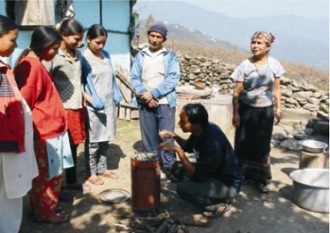Atmospheric Environment, Volume 45, Issue 19, June 2011, Pages 3237-3243
Modeling indoor air pollution from cookstove emissions in developing countries using a Monte Carlo single-box model
Michael Johnsona, , , Nick Lama, b, Simone Branta, Christen Graya and David Pennisea
a Berkeley Air Monitoring Group, 2124 Kittredge St #57, Berkeley, CA 94704, USA
b Environmental Health Sciences, University of California, 725 University Hall, Berkeley, CA 94720, USA
A simple Monte Carlo single-box model is presented as a first approach toward examining the relationship between emissions of pollutants from fuel/cookstove combinations and the resulting indoor air pollution (IAP) concentrations. The model combines stove emission rates with expected distributions of kitchen volumes and air exchange rates in the developing country context to produce a distribution of IAP concentration estimates. The resulting distribution can be used to predict the likelihood that IAP concentrations will meet air quality guidelines, including those recommended by the World Health Organization (WHO) for fine particulate matter (PM2.5) and carbon monoxide (CO). The model can also be used in reverse to estimate the probability that specific emission factors will result in meeting air quality guidelines.
The modeled distributions of indoor PM2.5 concentration estimated that only 4% of homes using fuelwood in a rocket-style cookstove, even under idealized conditions, would meet the WHO Interim-1 annual PM2.5 guideline of 35 μg m−3. According to the model, the PM2.5 emissions that would be required for even 50% of homes to meet this guideline (0.055 g MJ-delivered−1) are lower than those for an advanced gasifier fan stove, while emissions levels similar to liquefied petroleum gas (0.018 g MJ-delivered−1) would be required for 90% of homes to meet the guideline. Although the predicted distribution of PM concentrations (median = 1320 μg m−3) from inputs for traditional wood stoves was within the range of reported values for India (108–3522 μg m−3), the model likely overestimates IAP concentrations.
Direct comparison with simultaneously measured emissions rates and indoor concentrations of CO indicated the model overestimated IAP concentrations resulting from charcoal and kerosene emissions in Kenyan kitchens by 3 and 8 times respectively, although it underestimated the CO concentrations resulting from wood-burning cookstoves in India by approximately one half. The potential overestimation of IAP concentrations is thought to stem from the model’s assumption that all stove emissions enter the room and are completely mixed. Future versions of the model may be improved by incorporating these factors into the model, as well as more comprehensive and representative data on stove emissions performance, daily cooking energy requirements, and kitchen characteristics.




{ 1 comment… read it below or add one }
hello to the people in charge, first thing first i should thank you for the great attempt you have made and the bother you have undertaken to release such useful information. i wish you had presented more information about the modeling the methods and approaches. methodology in conducting studies plays a key role and failing to get this part damages the understanding the approaches greatly.
thank you